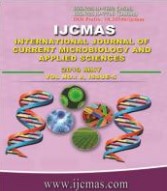


 National Academy of Agricultural Sciences (NAAS)
National Academy of Agricultural Sciences (NAAS)

|
PRINT ISSN : 2319-7692
Online ISSN : 2319-7706 Issues : 12 per year Publisher : Excellent Publishers Email : editorijcmas@gmail.com / submit@ijcmas.com Editor-in-chief: Dr.M.Prakash Index Copernicus ICV 2018: 95.39 NAAS RATING 2020: 5.38 |
Performance of milky mushroom (Calocybe indica) on different agricultural wastes like paddy straw, castor stalks, sunflower stalks, coconut coir pith, oil palm waste and groundnut shells was evaluated during the summer season. The spawning was done by sterilization of all the seven substrates. The bags were kept in spawn running room with the maintenance of temperature (30°C–35° C) and relative humidity (70–80 %) respectively. The minimum number of days required for completion of spawn run (30 days), primordial formation (10-15 days) and days for first harvest (40–45 days) was recorded with the paddy straw substrate followed by castor stalks where the minimum number of days required for completion of spawn run (33 days), primordial formation (10–15 days) and days for first harvest (43–48days). The experimental results revealed that paddy straw substrate was best and recorded an average yield of 1.0 to 1.5 kg per bed as compared to the other substrates. After paddy straw, the yield of milky mushrooms on coconut coir pith (806 g/ kg substrate) and oil palm waste (830 g/ kg substrate) was found on par with each other and yielded more compared to other substrates. Mushroom growers can adopt paddy straw substrate for growing milky mushrooms during summer season. The relative efficacy of the agricultural by-products analysed in the study indicated that paddy straw substrate is suitable for cultivation of milky mushrooms.
 |
 |
 |
 |
 |